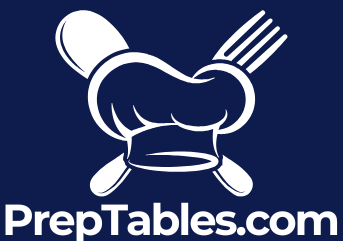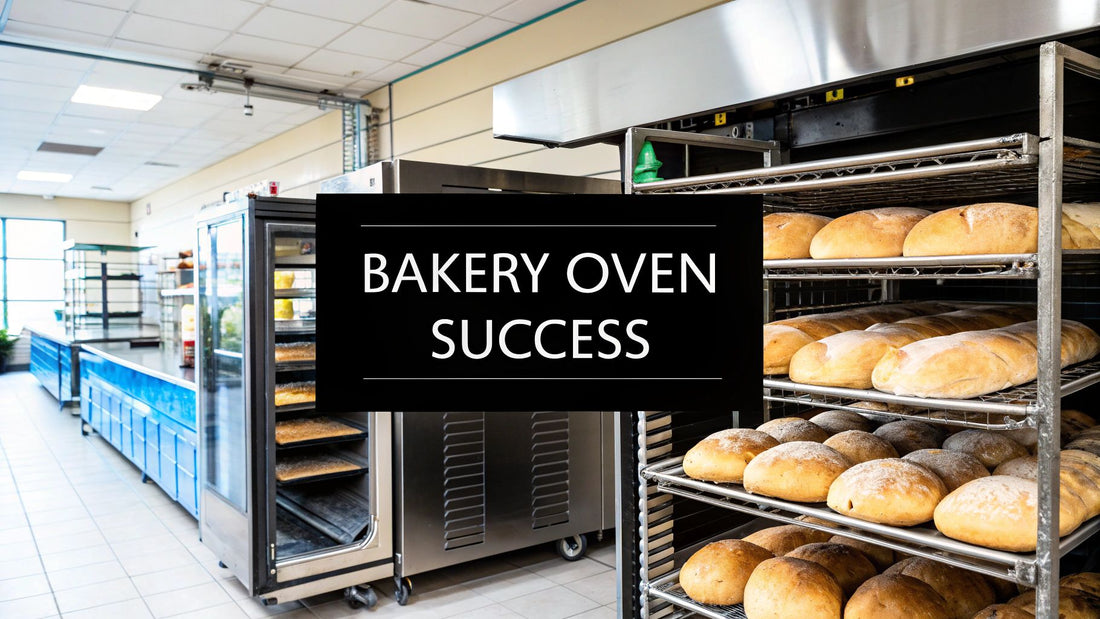
Choose the Best Commercial Ovens for Bakery Success
Share
Your commercial oven is so much more than just a piece of equipment; it's the engine that powers your entire bakery. The right commercial ovens for bakery success will determine the crust on your bread, the rise of your cakes, and the consistent quality of every single item you sell.
The Heart of Your Bakery Starts Here
Think of your oven as the central character in your bakery's story. It's one of the most critical decisions you'll make, and it all comes down to connecting the right oven to your specific business goals—whether you're running a small neighborhood artisan shop or a massive production facility. This single choice defines your brand's quality, your efficiency, and ultimately, your reputation. A great oven doesn't just bake; it builds your business from the inside out.
The growing demand for high-quality baked goods is easy to see in the market itself. In the United States, the commercial bakery oven market is already substantial, with a projected value of $1,197.1 million in 2025. And it's not slowing down. This sector is expected to grow to an impressive $1,894.9 million by 2035.
This infographic really drives home how the oven sits at the core of a successful bakery's day-to-day operations.
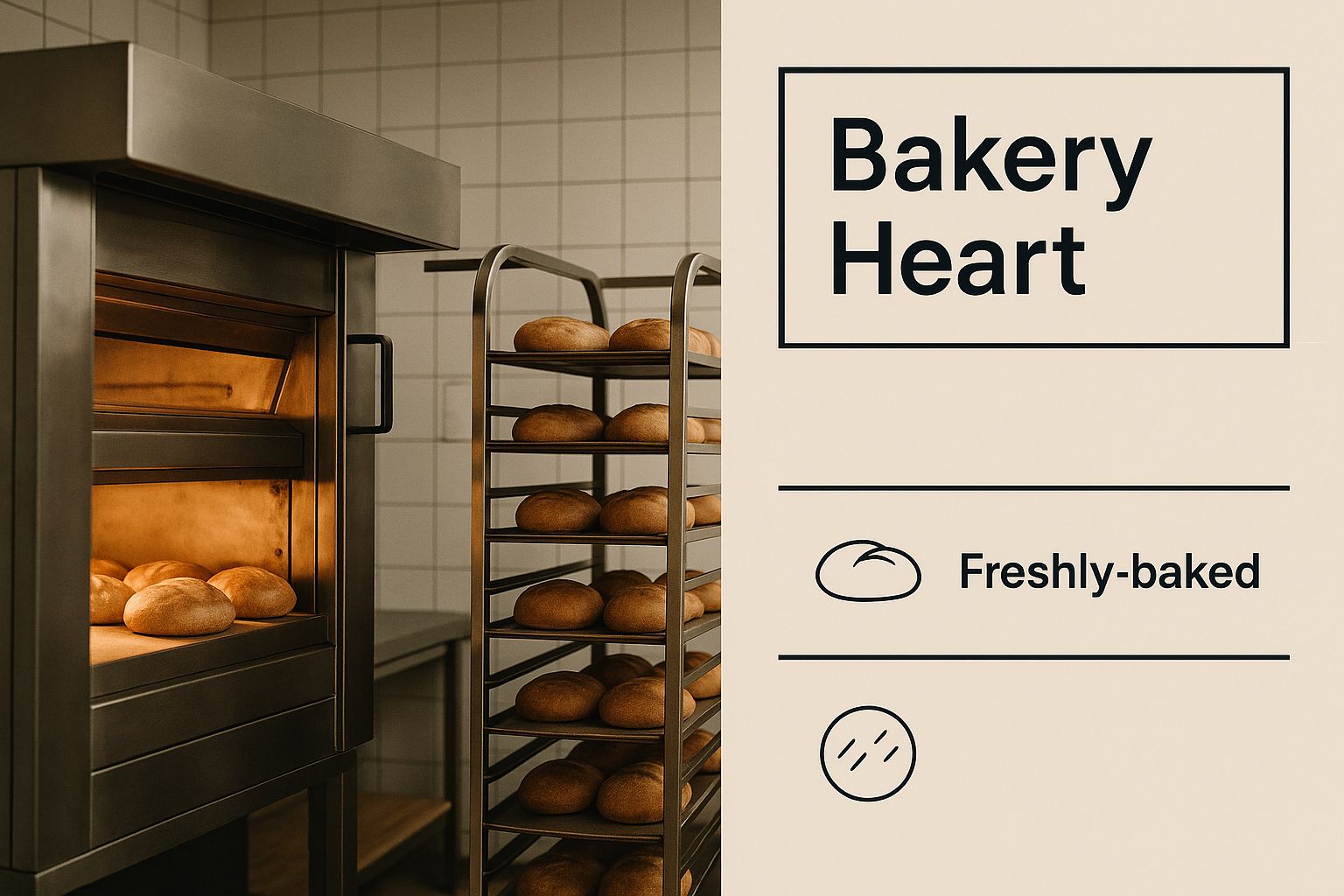
As you can see, everything revolves around that central hub. It directly impacts your product quality and how much you can actually produce. This guide is designed to go beyond the technical specs and help you understand the story each type of oven tells through the way it bakes.
Choosing Your Bakery's Foundation
Picking an oven is a lot like choosing the foundation for a house. It has to be strong, reliable, and perfectly suited for what you plan to build on top of it. Consider it your blueprint for achieving those consistent, delicious results that keep customers coming back for more.
So, what should you be thinking about? Here are the big three:
- Production Volume: Are you baking a few dozen cookies or hundreds of loaves every day?
- Product Type: Is your menu all about delicate pastries, or are you focused on hearty, crusty artisanal breads?
- Kitchen Space: How will the oven's footprint actually fit into your kitchen's workflow?
Your oven is your bakery's signature. It's the difference between a good loaf and a great one, turning simple ingredients into memorable experiences for your customers.
Of course, once you’ve baked those perfect goods, you need to show them off. Making sure your creations look as incredible online as they taste in person is crucial. For some great tips on that, check out this A Guide to Food Photography & Lighting for Restaurants.
Decoding the Main Types of Bakery Ovens
Choosing the right commercial oven for your bakery is a lot like a painter picking the right brush—the tool you use will absolutely define the final result. This decision shapes the texture, color, and consistency of every single thing that comes out of your kitchen.
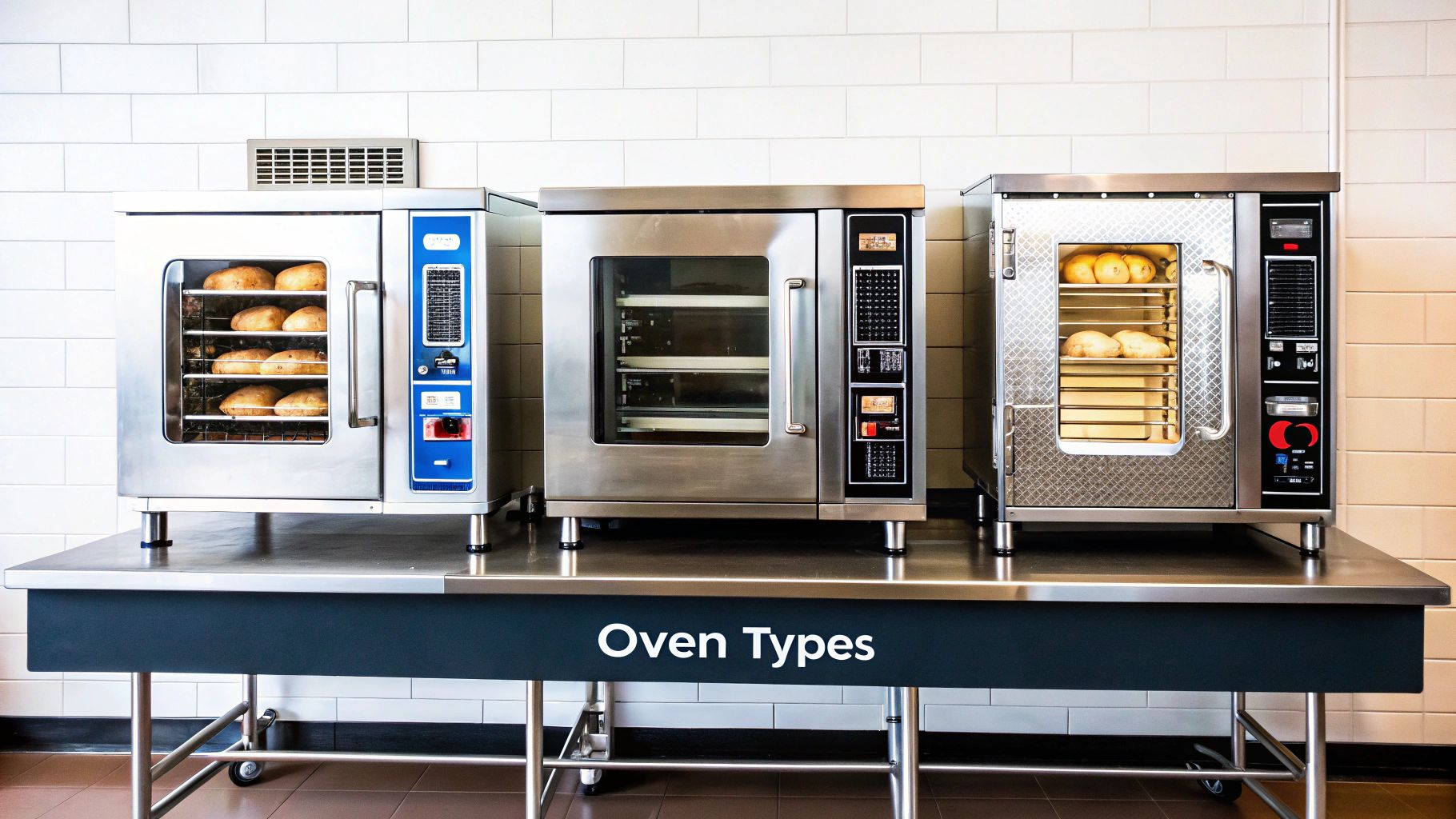
Let's walk through the three main types of commercial ovens for bakery use. We'll look at what makes each one tick and which baked goods really shine in their specific environments.
Convection Ovens: The Versatile Workhorse
Think of convection ovens as the all-rounders of the bakery world, perfect for a huge variety of products. They work by using a fan to constantly circulate hot air, almost like a high-powered hairdryer inside a box. This constant motion gets rid of hot spots, making sure every item on the pan gets hit with the same amount of heat from every direction.
This super-even heat distribution makes convection ovens a fantastic choice for:
- Cookies and Cupcakes: You get that perfect, uniform golden-brown color without having to spin trays halfway through the bake.
- Pastries: The moving air is a dream for puff pastry, helping it rise to impressive heights and giving it that beautiful, crisp texture.
- Quick Breads: Things like scones and muffins bake through quickly and evenly, which helps keep them moist on the inside.
Because they're so efficient, you can often bake at a slightly lower temperature or for less time. It's also worth remembering to consider the key differences between electric and gas ovens when you're weighing your options, as the fuel source plays a big role in performance and cost.
Deck Ovens: The Artisan's Choice
If convection ovens are all about speed and consistency, deck ovens are about tradition and control. These are the classic hearth-style ovens that give artisan breads their soul. Deck ovens rely on conductive heat, which means heat transfers directly from the hot stone or steel floor (the "deck") straight into the dough.
Imagine placing your hand on a warm stone—that direct, intense warmth is exactly how a deck oven works. This is the magic behind those thick, crackly crusts that bread lovers crave.
Deck ovens are the undisputed champions for baking rustic loaves like sourdough, baguettes, and ciabatta. Many models also have steam injection, a critical feature for getting that big "oven spring"—the rapid puff of the dough in the first few minutes of baking—and a beautiful, glossy crust. Their design, with separate decks, also lets you bake different breads at different temperatures all at the same time.
Rack Ovens: The High-Volume Powerhouse
When you just need to produce a massive amount of product, rack ovens are your answer. These are huge, powerful units built to bake entire rolling racks of goods in one go. A baker simply loads a full rack, packed with trays of dough, into the oven. Once inside, the rack either rotates or gets blasted with hot air from a powerful fan system.
This setup makes rack ovens the go-to for any high-volume bakery that needs to crank out hundreds, or even thousands, of items with rock-solid consistency. They are perfect for large-scale production of:
- Buns and rolls
- Sheet cakes
- Large batches of cookies
The sheer efficiency of a rack oven is unbeatable for commercial bakeries with serious daily quotas. They take up a lot of space, but the ability to bake an entire rack in a single cycle is a game-changer for workflow and productivity. For a deeper look into the specs of these machines, our guide on choosing an industrial baking oven has more detailed info.
Quick Guide to Commercial Bakery Ovens
To make things a bit clearer, here’s a simple table breaking down the key differences between these three oven types.
| Oven Type | Best For | Heat Method | Ideal Bakery Size |
|---|---|---|---|
| Convection | Cookies, pastries, cupcakes, quick breads | Circulated Hot Air | Small to Medium |
| Deck | Artisan breads (sourdough, baguettes) | Conductive Heat | Small to Medium, Artisan Focus |
| Rack | High-volume rolls, buns, sheet cakes | High-Powered Convection | Medium to Large, Wholesale |
Each oven has its place, and the best one for you truly depends on what you plan to bake and how much of it you need to produce every day.
Essential Features That Define Performance
Choosing your oven type is the first major decision, but the specific features are what really dictate how it performs day in and day out. These details make all the difference, from the flakiness of your croissants to your monthly utility bill. Learning to read a spec sheet like a seasoned pro ensures the oven you pick is a perfect match for your craft.
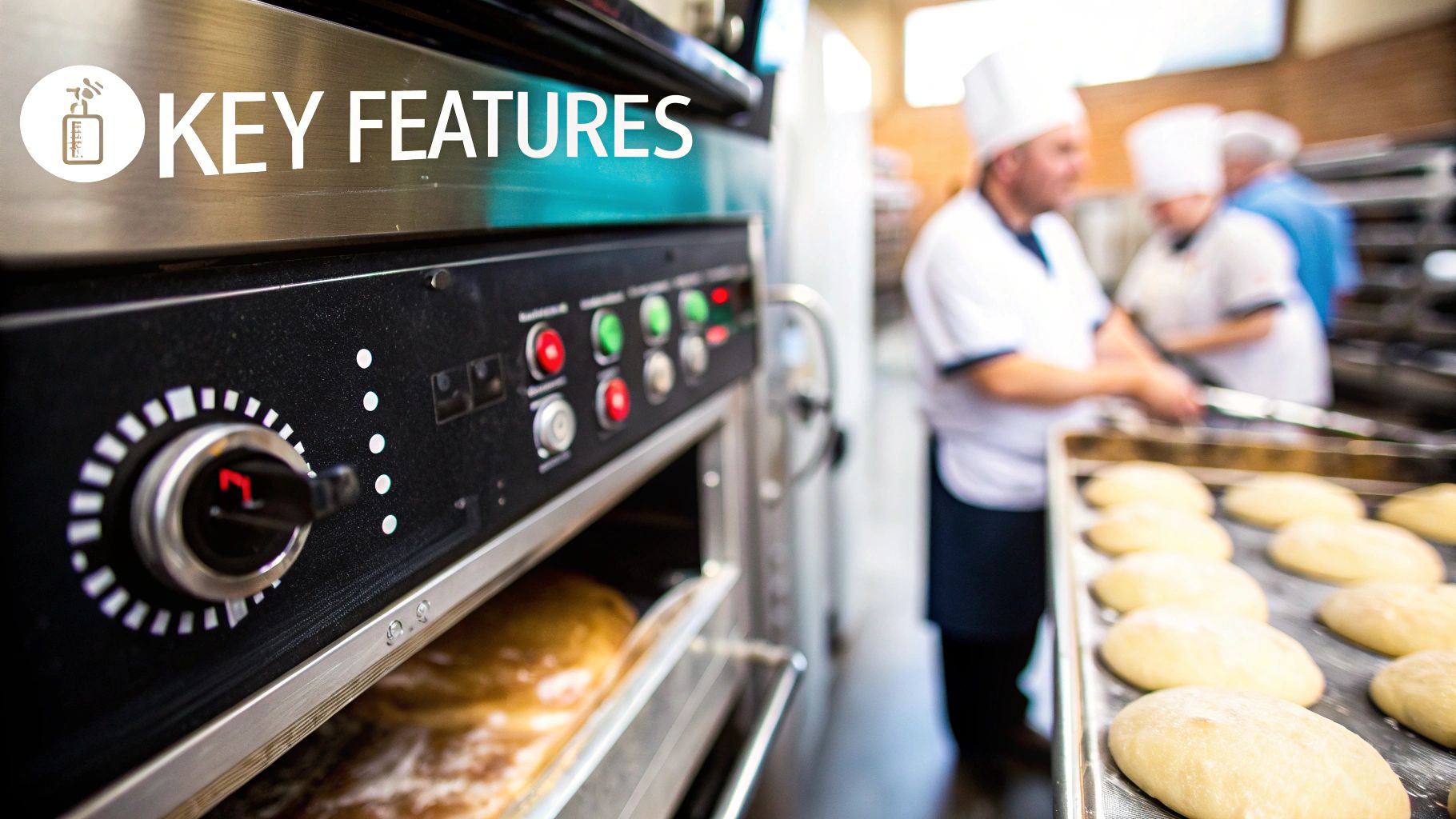
It’s this knowledge that helps you select not just a good oven, but the right oven. Let's dig into the critical features that separate a workhorse from just another piece of equipment.
Gas vs. Electric Power Sources
The gas versus electric debate is one of the first hurdles you'll face. Each power source offers a completely different baking environment—think of it like a painter choosing between oil and watercolor paints. Neither is flat-out better, but one is almost certainly a better fit for what you bake.
- Gas Ovens: These are known for heating up fast and producing a naturally moist heat. That environment is a dream for many breads, helping keep the crumb perfectly tender while the crust gets that perfect finish. Gas is also often cheaper to run.
- Electric Ovens: If you need absolute precision, electric is the way to go. They provide an incredibly dry, even heat that’s perfect for delicate items like macarons, meringues, and angel food cakes. For these bakes, exact temperature control isn't a luxury; it's a requirement.
Your choice here really boils down to your star products and what utilities cost in your area. An artisan bread maker will likely gravitate toward gas, while a high-end patisserie will find the precision of an electric oven essential.
Capacity and Footprint Considerations
Beyond the power source, the physical size of your oven determines your production ceiling and kitchen flow. Capacity is all about how much you can bake at once, usually measured by how many full-size sheet pans it holds. A small café might do just fine with a countertop model, but a high-volume bakery needs a multi-deck or rack oven to keep up.
The oven's footprint is its literal size—how it fits into your kitchen. It’s more than just square footage. You have to think about how the doors swing open and how your team will move around it during a chaotic morning rush. A massive, powerful oven is useless if it creates a permanent traffic jam.
Think of capacity as your oven's engine size and its footprint as the vehicle's frame. Both must be right for the job, or you'll constantly struggle with efficiency and workflow.
Advanced Features for Perfect Results
Modern commercial ovens for bakery use come loaded with features designed to give you total control over your final product. These aren’t just shiny bells and whistles; they’re powerful tools for achieving consistency.
One of the most important is steam injection. If you're baking any kind of artisan bread, this is a non-negotiable. A quick burst of steam right at the start of the bake keeps the dough's surface moist. This allows for that beautiful "oven spring" and creates the crisp, glossy crust you see on top-tier sourdoughs and baguettes.
Another game-changer is programmable controls. These let you save multi-stage recipes, locking in temperature and time settings with digital accuracy. It means every baker on your crew can produce the exact same result, batch after batch. That’s how you guarantee unwavering quality for your customers.
Expanding Your Bakery With Specialty Equipment
While the big three—convection, deck, and rack ovens—handle most of a bakery’s workload, sometimes you need a specialist. Certain bakeries can hit a whole new gear by bringing in equipment designed for a very specific job.
Think of these as precision tools. A revolving oven, for example, with its constantly rotating trays, is an absolute master of high-volume, uniform baking. It’s perfect for churning out bagels or hearth breads where every single piece needs that same perfect color and crust.
This kind of thinking shouldn't stop at the oven door. An efficient bakery is a well-oiled machine from start to finish. And the unsung heroes of that entire process? The prep tables that support every single step.
The Foundation of a Clean and Efficient Kitchen
Long before anything hits the heat of your commercial ovens for bakery use, it begins its life on a prep surface. This is where stainless steel prep tables prove their worth. There’s a reason stainless steel is the undisputed king of the commercial kitchen. It’s non-porous, incredibly tough, and a breeze to sanitize, making it the best choice for food safety.
Different kitchen tasks call for different types of prep tables. A solid, NSF-certified stainless steel work table provides a reliable, clean space for kneading dough or decorating cakes. Some tables come with an integrated backsplash to protect walls, while others feature an undershelf for extra storage, keeping essential tools and ingredients within easy reach.
As bakeries grow, so does the demand for great equipment. The global market for commercial bakery ovens was valued at $429.3 million in 2025 and is projected to keep climbing, powered by an ever-expanding food service industry.
Specialized Prep Tables for Expanded Menus
Just as you might choose a specialty oven, a specialized prep table can streamline your workflow, especially when expanding your menu. When a bakery branches out into café fare like sandwiches or pizza, refrigerated prep tables are a total game-changer for speed and safety.
- Pizza Prep Tables: These units combine a durable work surface (often a cutting board) with a refrigerated rail on top. This rail holds all your toppings—cheese, pepperoni, veggies—at a safe, cool temperature. Everything is organized and accessible, allowing for rapid, assembly-line-style pizza building.
- Sandwich Prep Tables: Operating on the same principle, these tables are a must-have for handling the lunch rush. They feature chilled wells for meats, cheeses, and spreads, keeping ingredients fresh and close at hand. This setup makes the entire process of building sandwiches smooth, safe, and efficient.
Think of a specialized prep table as your personal assistant. It organizes your ingredients, keeps them perfectly chilled, and puts everything you need right at your fingertips, turning a chaotic process into a smooth, efficient assembly line.
These units blend right into your kitchen's workflow, combining cold storage and prep space into one smart footprint. If you're adding pizza to your menu, pairing a pizza prep table with the right oven is crucial. You can dive deeper into finding the perfect commercial pizza oven in our detailed guide. By investing in the right specialty gear—for both baking and prep—you can grow your menu and make your whole operation run better.
Planning for Installation and Long-Term Care
Bringing a new commercial oven into your bakery is a big deal. It’s not just a delivery; it's a major operational upgrade, and you need to plan for it. A smooth installation is your first step toward years of reliable baking, and a solid maintenance routine is what protects that investment.
Honestly, the moment your new oven shows up on a truck is way too late to start thinking about the logistics. Getting prepared ahead of time saves you from expensive delays and gets your oven firing up as fast as possible.
Your Pre-Installation Checklist
Before that delivery truck even thinks about pulling up to your curb, you need a game plan. Think of it like laying the foundation for a house—a little work upfront ensures everything fits perfectly and, more importantly, safely.
Here’s a simple checklist to run through:
- Measure Everything Twice: Seriously. Check the oven’s dimensions against your doorways, any hallways it has to pass through, and its final home in the kitchen. Don't forget to leave enough clearance on all sides for proper ventilation and future maintenance access.
- Check Your Utilities: Make sure your electrical or gas lines can handle the new equipment. An electric oven might need a specific high-voltage circuit, while a gas model needs the right size supply line and a shut-off valve. A mismatch here is one of the most common—and costly—hang-ups during installation.
- Verify Ventilation Needs: Pretty much all commercial ovens for bakery use will require a ventilation hood. You need to check your local fire and health codes to ensure your entire exhaust system, hood and all, meets the legal standards for your specific type of oven.
A well-planned installation is the first step in preventative maintenance. Getting the setup right from the start eliminates a whole category of potential future problems, from poor performance to safety hazards.
Building a Long-Term Maintenance Routine
Once your oven is in and running, the goal shifts to keeping it in peak condition. A little regular care is far cheaper and way less stressful than dealing with an emergency repair that shuts down your entire production.
A good routine doesn't have to be complicated. You can break it down into simple daily, weekly, and monthly tasks that keep your oven running cleanly and efficiently. This proactive approach doesn't just make your oven last longer; it guarantees you get consistent baking results day in and day out. You can get more great tips on this in our guide to commercial kitchen equipment maintenance.
Simple Steps for Oven Longevity
Putting a maintenance schedule together is pretty straightforward. By assigning these small tasks to your team, you get everyone involved in protecting one of your bakery's most vital assets.
Daily Tasks (5-10 minutes):
- Wipe Down Surfaces: At the end of the day, give the exterior and interior a good wipe-down to get rid of grease and food bits.
- Clear Debris: Brush out any crumbs or gunk from the oven floor and around the door seals.
Weekly Checks (15-20 minutes):
- Inspect Door Gaskets: Check the seals around the door for any cracks or wear. A bad gasket means you're just leaking heat and wasting energy.
- Test Controls and Thermostat: Run the oven for a few minutes to make sure the thermostat is reading accurately and all the knobs and buttons are working as they should.
- Clean Fan Blades: If you can safely access them, wipe down the convection fan blades. Buildup can throw the fan off balance and put a strain on the motor.
Your Bakery Oven Questions, Answered
Picking out the heart of your bakery—the oven—is a huge deal, and it's totally normal to have a few last-minute questions. Think of this as a quick chat to clear up some of the most common things bakers ask, so you can feel great about your final choice.
Finalizing your oven is a major milestone, but that's often when the really specific, practical questions pop up. Getting these details right is what makes the difference between a good purchase and a smart investment that will truly serve your business for years to come.
What Is the Best Oven for a Small Startup Bakery?
For most startups, a single or double-stack convection oven is going to be your most versatile and budget-friendly friend. It's a real workhorse, perfect for everything from cookies and cakes to pastries. Plus, its smaller footprint is a lifesaver in tight kitchen spaces.
Now, if your dream is to be an artisan bread specialist, a small deck oven might be calling your name. But honestly, a convection oven gives you the flexibility to offer a wider variety of items right out of the gate, which is a huge advantage when you're just starting out.
How Much Should I Budget for a Commercial Bakery Oven?
This is a big one, and the answer is: it varies—a lot. The price tag depends heavily on the oven type, its size, and any special features. It's crucial to think about the total investment, not just the sticker price.
- Entry-Level: You can find a decent countertop convection oven starting around $2,000.
- Mid-Range: A full-size, single-deck gas convection oven will likely run you $5,000 to $15,000.
- Specialty: Deck ovens for that perfect bread crust often start at $7,000 and can climb past $30,000.
- High-Volume: If you're going big, a large rack oven can easily exceed $40,000.
Don't forget to factor in installation, ventilation, and any potential electrical or gas line upgrades. The price of the oven itself is just one piece of the puzzle to get it fired up and ready to bake in your kitchen.
Is Steam Injection a Necessary Feature?
This all comes down to your menu. If you're baking artisan breads—think beautiful baguettes or crusty sourdough—then yes, steam injection is non-negotiable.
That blast of steam keeps the dough's surface moist for the first few minutes of baking, which allows it to expand as much as possible (that's the "oven spring" bakers obsess over). It's the secret to getting that amazing, crisp, glossy crust everyone loves. For most cakes, cookies, and quick breads, though, you won't need it.
What Is the Difference Between Gas and Electric Ovens?
Gas and electric ovens are two different beasts, creating distinct baking environments. The right choice for you will depend on what you're baking, your local utility costs, and frankly, your personal baking style.
Gas ovens tend to heat up faster and produce a moister heat, which can be fantastic for certain types of bread and even roasts. They are also often cheaper to run month-to-month.
Electric ovens, on the other hand, deliver a very dry, even heat. This makes them the champion for delicate bakes like macarons, angel food cakes, and pastries where pinpoint temperature accuracy is key to getting flawless results.
At PrepTables.com, we know that the right oven is the foundation of every great bakery. Take a look at our huge selection of commercial ovens and stainless steel prep tables to build a kitchen that’s as hardworking as you are. Find your perfect match today.
